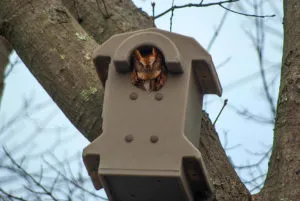Screech owls, small but fascinating cavity-nesting birds, exhibit unique screech owl breeding habits that make them a favorite among backyard bird enthusiasts. These nocturnal predators return to familiar sites each year, engaging in elaborate courtship rituals before laying eggs in tree hollows or nest boxes. Understanding their breeding cycle—from territory reclamation to fledgling dispersal—helps bird lovers support these resilient owls in their local environments. Whether you’re setting up a nest box or simply observing from afar, knowing these patterns enhances appreciation for their survival strategies.
 Red phase screech owl perched in nest box
Red phase screech owl perched in nest box
Screech Owl Breeding Season
Screech owl breeding habits kick off amid winter’s harsh conditions, with males returning to last year’s sites—natural tree cavities or purpose-built nest boxes—between late December and mid-February. Amid snow and wind, they reclaim territory through persistent calling and roosting in the cavity or nearby trees. By mid-March, as trees bud and early flowers emerge, females arrive from winter hunting grounds.
The pair bonds through mutual calling, preening, and mating before egg-laying. Females scout roosting spots near the site while males call from inside the cavity. Eventually, the female settles in, leaving only at dusk for the male to deliver food. He roosts close by, maintaining contact with soft trills. This phase offers prime viewing opportunities for observers, as the owls are active and vocal. According to the Cornell Lab of Ornithology, such behaviors ensure territory defense and pair synchronization essential for successful reproduction.
Screech Owl Eggs
Egg-laying typically starts in the third week of March. Unlike many owls that space eggs every two days, screech owls lay the first three daily, followed by longer gaps. Clutches average four eggs, though five or six occur frequently, aligning with data from Animal Diversity Web reports of 2-7 eggs per clutch.
These plain white eggs, characteristic of cavity nesters, require no camouflage. The female develops a brood patch to incubate them effectively, as noted in studies from the Audubon Society.
Incubation Period
Incubation demands precision: the female rotates eggs under her bare patch to maintain optimal temperature. She broods continuously while the male hunts and delivers prey faithfully. Eggs hatch after 29-31 days on average, coinciding with late April leaf-out—around 26-34 days per Cornell Lab observations.
Hatching success hovers at 50-60%, lower than many owls due to factors like asynchronous hatching and siblicide in larger broods. Males adjust roosting: 14-20 feet away during incubation, closer to six feet at hatching, then farther post-hatch. Monitoring the male’s position signals key events inside the nest.
Development of Young Screech Owls
Newly hatched owlets rely on the female for brooding, who takes brief 10-30 minute breaks at dusk and dawn for preening and male interaction. Males deliver whole or headless prey; females tear it into swallowable bits for nestlings—a division of labor common in owls.
Owlets grow rapidly, achieving adult weight and flight feathers in 24-32 days. Parents then encourage fledging by withholding food and removing cached prey, prompting independence.
The Fledging Period
Fledging begins late May to early June, with owlets hopping to nearby branches. Despite adult size, they need days to strengthen flight muscles. They cluster, begging from both parents, progressing to 30-foot flights in 3-5 days and matching adults by week two.
This vulnerable phase sees high predation risk, including from great horned owls. For insights into similar great horned owl nesting behavior, young screech owls learn hunting basics—insects first—while clumsy. They linger 8-10 weeks in the area, honing skills up to 300 feet from the nest.
Fledgling Dispersal
By August or early September, juveniles master hunting diverse prey like crickets, moths, shrews, and mice. Unlike migratory barn owls, screech owls disperse short distances—1.25 to 2 miles from natal sites—often breeding nearby as yearlings.
Attracting Screech Owls with Nest Boxes
Screech owls readily accept nest boxes, mirroring their natural cavity preferences. Proper placement and design boost occupancy, aiding populations amid habitat loss. Experienced observers note higher success with boxes mimicking woodpecker holes.
In summary, screech owl breeding habits showcase remarkable adaptability, from early territorial claims to post-fledging training. Supporting them through nest boxes and minimal disturbance fosters biodiversity in your yard. Consult local wildlife experts or install a suitable box to witness this cycle firsthand—your backyard could host future generations.
References
- Cornell Lab of Ornithology. “Eastern Screech-Owl Life History.” All About Birds. allaboutbirds.org
- Audubon Field Guide. “Eastern Screech-Owl.” audubon.org
- Animal Diversity Web. “Otus asio (eastern screech owl).” University of Michigan. animaldiversity.org
